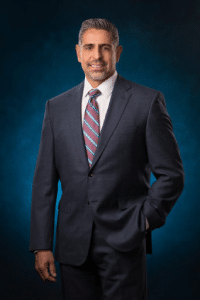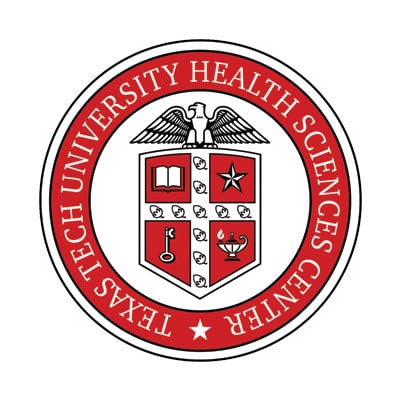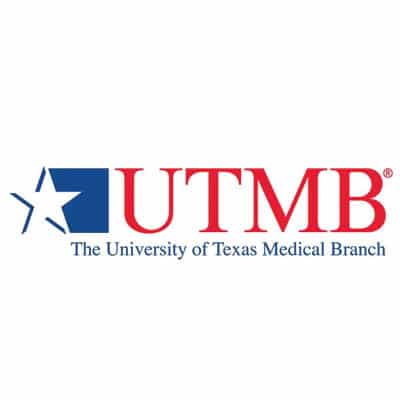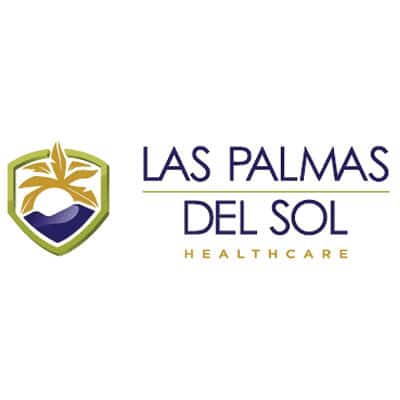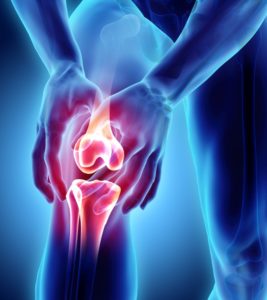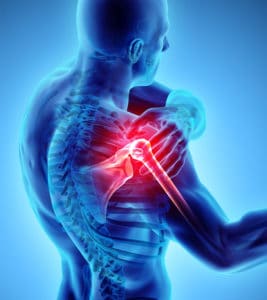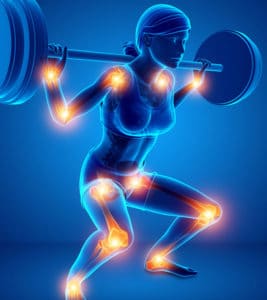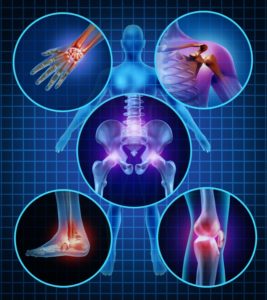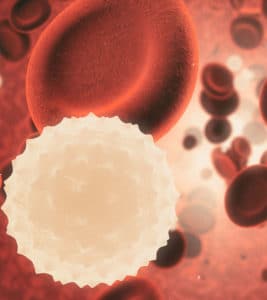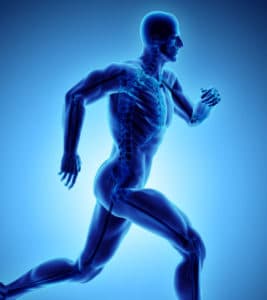Total and Reverse Total Shoulder Replacement Rehab
General Information:
Reverse or Inverse Total Shoulder Arthroplasty (rTSA) is designed specifically for the treatment of glenohumeral (GH) arthritis when it is associated with irreparable rotator cuff damage, complex fractures as well as for a revision of a previously failed conventional Total Shoulder Arthroplasty (TSA) in which the rotator cuff tendons are deficient. It was initially designed and used in Europe in the late 1980s by Grammont; and only received FDA approval for use in the United States in March of 2004.
The rotator cuff is either absent or minimally involved with the rTSA; therefore, the rehabilitation for a patient following the rTSA is different than the rehabilitation following a traditional TSA. The surgeon, physical therapist and patient need to take this into consideration when establishing the postoperative treatment plan.
Important rehabilitation management concepts to consider for a postoperative physical therapy rTSA program are:
• Joint protection: There may be a higher risk of shoulder dislocation following rTSA than a conventional TSA.
O Avoidance of shoulder extension past neutral and the combination of shoulder adduction and internal rotation should be avoided for 10-12 weeks postoperatively.
O Patients with rTSA don’t dislocate with the arm in abduction and external rotation. They typically dislocate with the arm in internal rotation and adduction in conjunction with extension. As such, tucking in a shirt or performing bathroom / persona hygiene with the operative arm is an especially dangerous activity particularly in the immediate peri-operative phase.
• Deltoid function: Stability and mobility of the shoulder joint is now dependent upon the deltoid and periscapular musculature. This concept becomes the foundation for the postoperative physical therapy management for a patient that has undergone rTSA.
• Function: As with a conventional TSA, maximize overall upper extremity function, while respecting soft tissue constraints.
• ROM: Expectation for range of motion gains should be set on a case-by-case basis depending upon underlying pathology. Normal/full active range of motion of the shoulder joint following rTSA is not expected.
Reverse Total Shoulder Arthroplasty Biomechanics
The rTSA prosthesis reverses the orientation of the shoulder joint by replacing the glenoid fossa with a glenoid base plate and glenosphere and the humeral head with a shaft and concave cup. This prosthesis design alters the center of rotation of the shoulder joint by moving it medially and inferiorly. This subsequently increases the deltoid moment arm and deltoid tension, which enhances both the torque produced by the deltoid as well as the line of pull / action of the deltoid. This enhanced mechanical advantage of the deltoid compensates for the deficient RC as the deltoid becomes the primary elevator of the shoulder joint. This results in an improvement of shoulder elevation and often individuals are able to raise their upper extremity overhead.
Figure 1. Anterior Posterior radiograph (A) and illustration (B) of a left shoulder with rotator cuff arthropathy. The superiorly migrated humeral head indicates rotator cuff deficiency.
Figure 2. Reverse Total Shoulder Arthroplasty Components . The prosthesis has 5 parts: the glenoid base, the glenosphere, a polyethylene cup, humeral neck, and the humeral stem.
Figure 3. Anterior Posterior radiography of a right shoulder (A) and an illustration of a left shoulder (B) after reverse total shoulder arthroplasty.
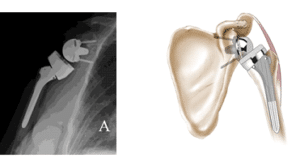
Reverse Total Shoulder Arthroplasty Protocol:
The intent of this protocol is to provide the physical therapist with a guideline/treatment protocol for the postoperative rehabilitation management for a patient who has undergone a Reverse Total Shoulder Arthroplasty (rTSA). It is by no means intended to be a substitute for a physical therapist’s clinical decision making regarding the progression of a patient’s postoperative rehabilitation based on the individual patient’s physical exam/findings, progress, and/or the presence of postoperative complications. If the physical therapist requires assistance in the progression of a postoperative patient who has had rTSA the therapist should consult with the referring surgeon.
The scapular plane is defined as the shoulder positioned in 30 degrees of abduction and forward flexion with neutral rotation. ROM performed in the scapular plane should enable appropriate shoulder joint alignment.
Shoulder Dislocation Precautions:
- No shoulder motion behind back. (NO combined shoulder adduction, internal rotation, and extension.)
- No glenohumeral (GH) extension beyond neutral.
*Precautions should be implemented for 12 weeks postoperatively unless surgeon specifically advises patient or therapist differently.
Surgical Considerations:
The surgical approach needs to be considered when devising the postoperative plan of care.
• Traditionally rTSA procedure is done via a typical deltopectoral approach, which minimizes surgical trauma to the anterior deltoid.
• Some surgeons perform this procedure via a superior approach, retracting the anterior deltoid from the anterior lateral one third of the clavicle. This allows for superior exposure to the GH joint between the retracted anterior deltoid and the clavicle. Upon surgical closure the anterior deltoid is sutured back to its anatomical location. In these cases early deltoid activity is contraindicated. Progression thru the post operative protocol may be slowed down to respect the fact that the deltoid needs time heal.
The start of this protocol may be delayed 3-4 weeks following rTSA for a revision and/or in the presence of poor bone stock based on the surgeon’s assessment of the integrity of the surgical repair. In the case of a delayed start to physical therapy adjust below timeframes so that day 1 is the first day of physical therapy.
Progression to the next phase based on Clinical Criteria and Time Frames as Appropriate.
Phase I – Immediate Post Surgical Phase/Joint Protection (Day 1-6 weeks):
Goals:
• Patient and family independent with:
o Joint protection
o Need for in clinic and home passive range of motion (PROM)
o Assisting with putting on/taking off sling and clothing o Assisting with home exercise program (HEP)
o Cryotherapy
• Promote healing of soft tissue / maintain the integrity of the replaced joint.
• Enhance PROM.
• Restore active range of motion (AROM) of elbow/wrist/hand.
• Independent with activities of daily living (ADL’s) with modifications.
• Independent with bed mobility, transfers and ambulation or as per pre-admission status.
Phase I Precautions:
• Sling is worn for 2-4 weeks postoperatively and removed for exercise and bathing. As the patient demonstrates good pain relief and control of his/her UE they should spend time out of their sling in controlled environments. If a patient is in their sling 24/7 for the full first 4 weeks post op they may risk getting stiff. The use of a sling may be extended for a total of 6 weeks, if the current rTSA procedure is a revision surgery.
• While lying supine, the distal humerus / elbow should be supported by a pillow or towel roll to avoid shoulder extension. Patients should be advised to “always be able to visualize their elbow while lying supine.” • No shoulder AROM.
• No lifting of objects with operative extremity.
• No supporting of body weight with involved extremity.
• Keep incision clean and dry (no soaking/wetting for 2 weeks); No whirlpool, Jacuzzi, ocean/lake wading for 4 weeks.
Acute Care Therapy (Day 1 to 4):
• Begin PROM in supine after complete resolution of interscalene block.
o Forward flexion and elevation in the scapular plane in supine to 90-120 degrees as tolerated.
o External rotation (ER) in scapular plane to available ROM as indicated by operative findings. Typically around 20-30 degrees.
o No Internal Rotation (IR) range of motion (ROM).
• Active/Active Assisted ROM (A/AAROM) of cervical spine, elbow, wrist, and hand.
• Begin periscapular sub-maximal pain-free isometrics in the scapular plane.
• Continuous cryotherapy for first 72 hours postoperatively, then frequent application (4-5 times a day for about 20 minutes).
• Insure patient is independent in bed mobility, transfers and ambulation • Insure proper sling fit/alignment/ use.
• Instruct patient in proper positioning, posture, initial home exercise program
• Provide patient/ family with written home program including exercises and protocol information.
Day 5 to 21:
• Continue all exercises as above (typically 2-3 times per day).
• Supine AAROM flexion with cane/stick; start with short lever motion then progress to long lever motion
• AAROM flexion dusting progression (counter and railing with towel) • Frequent (4-5 times a day for about 10-20 minutes) cryotherapy.
3 Weeks to 6 Weeks:
• Progress exercises listed above.
• Begin sub-maximal pain-free deltoid isometrics in the scapula plane (avoid shoulder extension when isolating posterior deltoid)
• Progress PROM:
o Forward flexion and elevation in the scapular plane in supine to 120-140 degrees as tolerated.
o ER in scapular plane to tolerance, respecting soft tissue constraints.
• AAROM flexion dusting progression (railing progressed to vertical surface
(wall) with towel
• Gentle resisted exercise of elbow, wrist, and hand.
• Continue frequent cryotherapy.
Criteria for progression to the next phase (Phase II):
• Tolerates shoulder PROM, AAROM and isometrics; and, AROM- minimally resistive program for elbow, wrist, and hand.
• Patient demonstrates the ability to isometrically activate all components of the deltoid and periscapular musculature in the scapular plane.
Phase II –Active Range of Motion / Early Strengthening Phase (Week 6 to 12):
Goals:
• Continue progression of PROM (full PROM is not expected).
• Gradually restore AROM (Lawn chair progression is recommend if patient is having a difficult time with sitting/standing AROM flexion against full gravity).
• Control pain and inflammation.
• Allow continued healing of soft tissue / do not overstress healing tissue.
• Re-establish dynamic shoulder and scapular stability.
Precautions:
• Due to the potential of an acromion stress fracture one needs to continuously monitor the exercise and activity progression of the deltoid. A sudden increase of deltoid activity during rehabilitation could lead to excessive acromion stress. A gradually progressed pain free program is essential.
• Continue to avoid shoulder hyperextension.
• In the presence of poor shoulder mechanics avoid repetitive shoulder AROM exercises/activity.
• Restrict lifting of objects to no heavier than a coffee cup (1-2 lbs). • No supporting of body weight by involved upper extremity.

